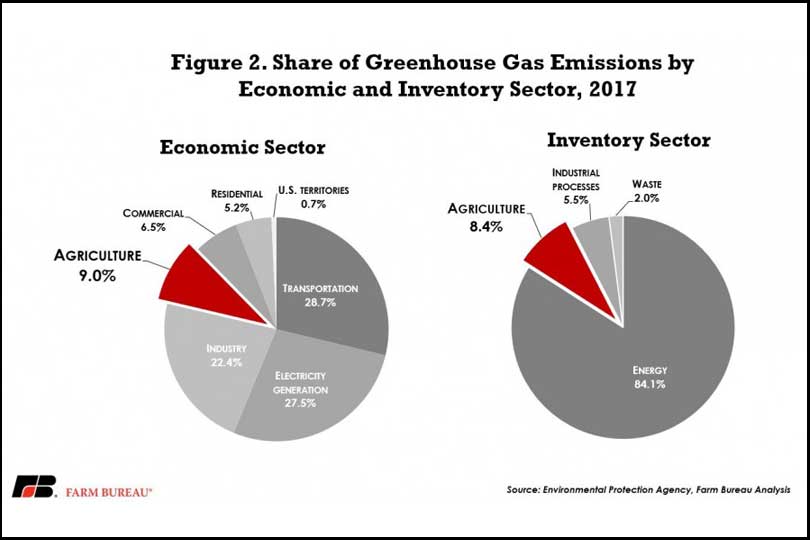By Jessica Domel
Multimedia Reporter
Over the past few months, there have been a barrage of media reports and some public figures blaming the livestock industry for a range of issues, including rising greenhouse gas (GHG) emissions and climate change.
A new report from the Environmental Protection Agency (EPA) reveals the truth about agriculture’s role.
“The latest information from the EPA indicates that agriculture’s greenhouse gas emissions in 2017 represent about 9 percent total greenhouse gas emissions in the U.S.,” Dr. John Newton, chief economist for the American Farm Bureau Federation, said in an interview with the Texas Farm Bureau (TFB) Radio Network.
In 2017, there were about 6.5 billion metric tons of GHG emitted in the U.S.
That’s down .3 percent from 2016 levels and is the lowest level recorded in 25 years.
“When including land use, land-use changes and forestry, net greenhouse gas emissions totaled 5.8 million metric tons in carbon dioxide equivalents,” Newton said.
The decline can be attributed to lower fossil fuel combustion, a shift from coal to natural gas and increased use of renewable fuels.
The transportation sector represented 29 percent of all GHG emissions in 2017—the highest level in nine years. The energy sector represented 28 percent.
While methane emissions from livestock are frequently blamed, Newton said it is important to note agriculture contributed only a fraction of what other sectors emitted.
“There’s two sides to this coin. The one side acknowledging methane emissions are more potent, and larger contributors to climate changes, according to the scientists, than carbon dioxide,” Newton said. “At the same time, methane has a much smaller half-life than carbon dioxide.”
Total methane emissions from livestock in 2017 represent about three percent of total GHG emissions.
Newton said it’s also important to consider the major improvements in agriculture’s productivity and sustainability.
“So when you consider that we’re producing 130 percent more food today than we did in 1990, while using the same amount of inputs, that’s a productivity gain,” Newton said. “If you apply those productivity gains on cattle and on dairy, you see that greenhouse gas—methane—emissions from cattle and dairy have declined by 10 and 25 percent, respectively, since 1990.”
Methane digesters and other new technologies have allowed dairies, feedlots and other segments of the livestock industry to take what once was considered a waste and turn it into something usable like renewable fuels.
“We’re only going to continue to get better at that with more investments in that space,” Newton said. “That’s because the industry has its eye on reducing their carbon footprint.”
The 9 percent of GHG emissions attributed to agriculture has been relatively flat for decades, but at the same time, farmers and ranchers are producing record crops and record production of livestock.
Earlier this year when Congress was considering the “Green New Deal,” a non-binding resolution that called for a 10-year effort to build smart power grids, achieve net-zero GHG emissions and remove pollution and GHG emissions from transportation and agriculture.
Opponents said the deal would, among other things, hit rural Americans the hardest because they have to travel further and have, on average, lower incomes.
“I think it’s just a general lack of understanding of agriculture and of agricultural production practices. Many people think milk comes from a grocery store,” Newton said.
The resolution fell in the Senate in a 57-0 vote in late March.
Newton said it is proposals like these that highlight the need to engage the public.
“We’ve just got to do a better job of telling the story of agriculture, of getting the facts out there because there is a lot of misinformation,” Newton said. “I think in today’s social media, instant gratification world, people can have a voice. They can have a voice to say anything they want.”
It’s important for farmers, ranchers, dairymen and those involved in every aspect of agriculture to have a good conversation with customers, consumers and lawmakers about what agriculture can do to continue on our long path to sustainability, according to Newton.
In 2017, thanks to substantial improvements in crop yields, U.S. farmer

